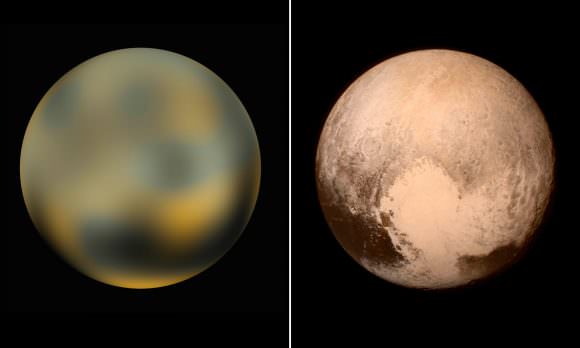On July 14th, 2015, the New Horizons probe made history as it passed within 12,500 km (7,800 mi) of Pluto, thus making it the first spacecraft to explore the dwarf planet up close. And since this historic flyby, scientists and the astronomy enthusiasts here at Earth have been treated to an unending stream of breathtaking images and scientific discoveries about this distant world.
And thanks to the New York Times and the Universities Space Research Association‘s Lunar and Planetary Institute in Texas, it is now possible to take a virtual reality tour of Pluto. Using the data obtained by the New Horizon’s instruments, users will be able to experience what it is like to explore the planet using their smartphone or computer, or in 3D using a VR headset.
The seven-minute film, titled “Seeking Pluto’s Frigid Heart“, which is narrated by science writer Dennis Overbye of the New York Times – shows viewers what it was like to approach the dwarf planet from the point of the view of the New Horizon’s probe. Upon arrival, they are then able to explore Pluto’s surface, taking in 360 degree views of its icy mountains, heart-shaped plains, and largest moon, Charon.
This represents the most detailed and clear look at Pluto to date. A few decades ago, the few maps of Pluto we had were the result of close observations that measured changes in the planet’s total average brightness as it was eclipsed by its largest moon, Charon. Computer processing yielded brightness maps, which were very basic by modern standards.
In the early 2000s, images taken by the Hubble Space Telescope were processed in order to create a more comprehensive view. Though the images were rather undetailed, they offered a much higher resolution view than the previous maps, allowing certain features – like Pluto’s large bright spots and the dwarf planet’s polar regions – to be resolved for the first time.
However, with the arrival of the New Horizons mission, human beings have been finally treated to a close-up view of Pluto and its surface. This included Pluto’s now-famous heart-shaped plains, which were captured by the probe’s Long Range Reconnaissance Imager (LORRI) while it was still several days away from making its closest approach.

This was then followed-up by very clear images of its surface features and atmosphere, which revealed floating ice hills, mountains and icy flow plains, and surface clouds composed of methane and tholins. From all of these images, we now know what the surface of this distant world looks like with precision. All of this has allowed scientists here at Earth to reconstruct, in stunning detail, what it would be like to travel to Pluto and stand on its surface.
Amazingly, only half of New Horizon’s images and measurements have been processed so far. And with fresh data expected to arrive until this coming October, we can expect that scientists will be working hard for many years to analyze it all. One can only imagine what else they will learn about this mysterious world. And one can only hope that any news findings will be uploaded to the app (and those like it)!

